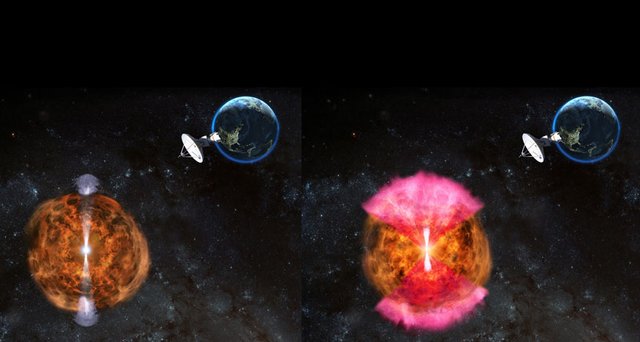 The neutron star collision heard and seen around the world has failed to fade. That lingering glow could mean that a jet of bright matter created in the crash has diffused into a glowing, billowy cocoon that surrounds the merged star, researchers report online December 20 in Nature.
The neutron star collision heard and seen around the world has failed to fade. That lingering glow could mean that a jet of bright matter created in the crash has diffused into a glowing, billowy cocoon that surrounds the merged star, researchers report online December 20 in Nature.
Gravitational waves from the collision between two ultradense stellar corpses was picked up in August by the Advanced Laser Interferometer Gravitational-Wave Observatory, LIGO, and its sister experiment in Italy, Advanced Virgo (SN: 11/11/17, p. 6). Using telescopes on the ground and in space, physicists raced to conduct follow-up observations, and found that the collision released light across the electromagnetic spectrum.
Right away, the event looked unusual, says astrophysicist Kunal Mooley, who conducted the research while at the University of Oxford. Physicists think that a jet of fast-moving, bright material blasts out of the center of neutron star collisions. If that jet is aimed directly at Earth, telescopes can see it as an ephemeral flash of light called a short gamma-ray burst, or GRB.
But the gamma-ray signals produced by the August collision were 10,000 times less bright than those seen in other detected short gamma-ray bursts. Even stranger, X-rays and radio waves from the event didn’t appear until about 16 days after the collision. Most short gamma-ray bursts are visible in X-rays and radio waves right away and fade over time.
Astronomers thought those oddities meant the jet was facing slightly away from Earth and expected the light to fade quickly. But Mooley and colleagues continued tracking the glow with three radio telescope arrays on three continents for more than 100 days after the collision. Radio wave emissions continued to brighten for at least 93 days, and are still visible now, the team found. (X-rays were temporarily blocked when the neutron star moved behind the sun from Earth’s perspective.)
“This thing continues to rise, instead of fading into oblivion as we expected,” says astrophysicist Wen-fai Fong of Northwestern University in Evanston, Ill., who was not involved in the new study.
The finding may mean that astronomers are seeing a new kind of gamma-ray burst. Mooley and colleagues suggest that the rise in radio wave emissions could be explained if the jet slammed into a shell of neutron-rich material kicked out in the neutron star crash, transferring most of its energy to that debris and smothering the jet. That extra energy could create a glowing cocoon that keeps radiating far longer than the original blast.
The new result is “really challenging our understanding of what physics is happening from this merger,” Fong says. But, she adds, “the jury is still out on whether this is the same as the short GRBs we’ve seen over the past decade, or whether it’s something completely different,” such as a luminescent cocoon. She and her colleagues also took radio wave observations of the merged stars in the first 100 days after the collision. The team is preparing a paper with a different interpretation that includes a jet emerging from the wreckage later, she says.
Other explanations for the lingering light are possible, Mooley acknowledges. Future detections “will give us an opportunity to really study … what fraction of neutron star mergers give rise to [short] GRBs and what fraction give rise to other phenomena and explosions that we haven’t seen so far in our universe,” he says.
Hi! I am a robot. I just upvoted you! I found similar content that readers might be interested in:
https://www.sciencenews.org/article/smothered-jet-may-explain-weird-light-neutron-star-crash
Downvoting a post can decrease pending rewards and make it less visible. Common reasons:
Submit